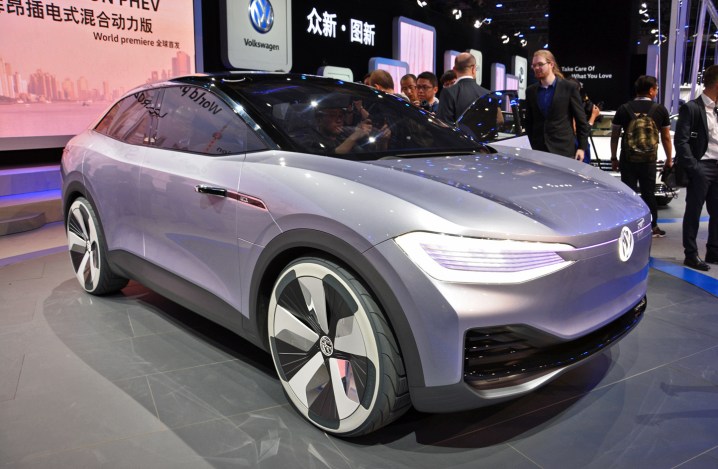Volkswagen is planning to launch a range of electric cars beginning around 2020, and it’s previewing that brave new electric world with a series of concept vehicles. First came the Volkswagen I.D. hatchback concept, then the I.D. Buzz, a tribute to the classic VW Microbus. Volkswagen expanded the family with a swoopy crossover earlier this year (the Crozz), and the concept made its North American debut at the Los Angeles Auto Show. Now, we’ve learned that Volkswagen’s I.D. line will be entering production in November 2019.
Now, we’ve learned that Volkswagen’s I.D. line will be entering production in November 2019.
First shown in April at the 2017 Shanghai Auto Show, and updated for the Frankfurt show in September, the Volkswagen I.D. Crozz is an electric crossover that will satisfy the seemingly insatiable demand for these vehicles when it goes on sale. It’s not just a design study: the Wolfsburg, Germany-based brand has announced that we’ll see the production model on American roads in 2020. That announcement has been bolstered by recent reports noting that VW will begin producing the Crozz in the U.S. in just about 18 months. The goal is for the company to hit one million annual EV sales by 2025.
Like the other I.D. concepts, the oddly named Crozz is based on Volkswagen’s MEB platform for compact electric cars. VW says the styling makes this latest concept an SUV and a “four-door coupe” in one. That means the Crozz gets a sloping roofline that buyers will likely equate with sportiness, but that really just ruins practicality and makes the vehicle look like it’s been squashed by a heavy object landing on its roof. Nevertheless, the look is increasingly popular, as evidenced by the numerous brands adopting it.
Despite the squashed roof and compact proportions, Volkswagen says the Crozz has the same interior space as the 2018 Tiguan crossover. That’s owing to the MEB platform’s relatively long wheelbase, and the packaging efficiencies of an electric powertrain. With a battery pack under the floor and no bulky internal-combustion powertrain, designers have more flexibility.
The Crozz is powered by two electric motors, one for each axle. They produce a combined 302 horsepower, getting the little crossover up to a top speed of 112 mph. An 83-kilowatt-hour lithium-ion battery pack provides a claimed 311 miles of range on the European testing cycle, which is a bit more optimistic than the U.S. EPA cycle. The Crozz is equipped for DC fast charging, allowing it to charge to 80 percent in around 30 minutes. Volkswagen promises the production model will match — or improve upon — these specifications.
The Crozz is equipped for DC fast charging, allowing it to charge to 80 percent in around 30 minutes.
The Crozz also features a fully autonomous driving mode called “I.D. Pilot,” which is activated by pressing the Volkswagen logo on the steering wheel. In this mode, the exterior lighting changes to indicate the car is in autonomous mode, and occupants can take full advantage of the tech-filled cabin, which includes a 10.2-inch tablet-style display on the instrument panel. When the Crozz is parked, delivery services can drop off packages in its trunk.
Volkswagen plans to start production of its I.D. family of electric cars in 2020. The lineup will also include the I.D. hatchback, which will replace the e-Golf when it kicks off the offensive, and the retro-inspired I.D. Buzz, which will arrive in 2022. VW will begin production of the I.D. hatchback in November as well, but not in the U.S. The I.D. Buzz all-electric microbus should also be going into production soon given that it’s slated for delivery in 2022.
Update: Volkswagen will start production of the Crozz in the U.S. and the I.D. hatchback internationally beginning in November 2019.



